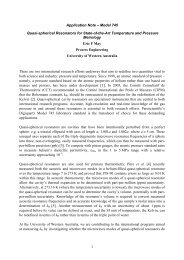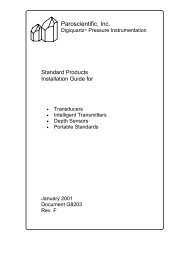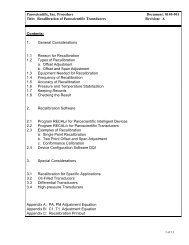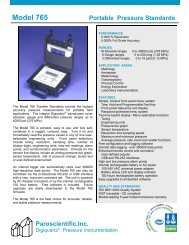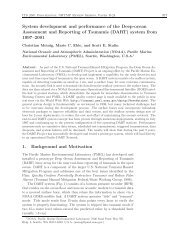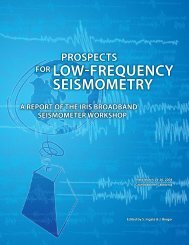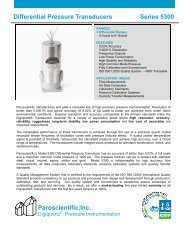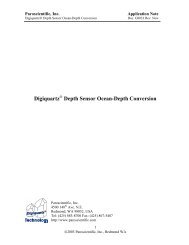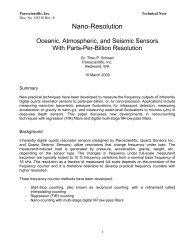Model 202BG Test Report - Paroscientific, Inc.
Model 202BG Test Report - Paroscientific, Inc.
Model 202BG Test Report - Paroscientific, Inc.
- No tags were found...
Create successful ePaper yourself
Turn your PDF publications into a flip-book with our unique Google optimized e-Paper software.
A New High-Precision Low-RangeBi-Directional Gauge Pressure SensorDr. Theo SchaadPrincipal Scientist<strong>Paroscientific</strong>, <strong>Inc</strong>.Description:The <strong>Model</strong> <strong>202BG</strong> is a bi-directional gauge pressure sensor that offers unparalleledprecision over the range of –15 to +15 kPa (-2 to +2 psig). The sensor is ideally suited foruse in high-precision gas calibrators and in portable transfer standards. The transducerprovides pressure and temperature frequency outputs and is fully characterized over atemperature range of 0 to 40 deg C and ambient static pressure of 80 to 110 kPa.The <strong>202BG</strong> provides sub-micron resolution (sensitivity) of 0.007 Pa (Pascal) and a totalaccuracy band better than 3 Pa (0.0004 psig) including repeatability, hysteresis, andconformance. Careful linearity tests against low-pressure primary standards have shownconformance is better than 0.2 Pa (rms). Temperature effects and common-modesensitivity are eliminated with a dynamic compensation equation that is provided by<strong>Paroscientific</strong>, <strong>Inc</strong>.Typical Application:A typical low-pressure manifold is shown in Appendix A. The <strong>202BG</strong> can serve as ahigh-precision monitor and calibration reference for direct input of bi-directional gaugepressure. In conjunction with a pressure source and pressure control, it is the idealsolution for a reference standard in a high-precision pressure calibrator. For optimalperformance, the static pressure should be monitored by an absolute pressure sensor witha range of 80 to 110 kPa, and the data should be processed with the provided temperatureand common-mode compensation equation. For overpressure protection, a dynamic shuntvalve should open outside the specified limits (overpressure above/below 120 % of fullscale). For shock protection, the <strong>202BG</strong> sensor is provided with a protective housing andflexible buffer-tubes.Pressure Equation:Appendix B shows the pressure algorithm. Each sensor is individually characterized.Coefficients are provided by <strong>Paroscientific</strong>. The basic pressure algorithm withtemperature compensation is identical to other <strong>Paroscientific</strong> instruments. In addition, acommon-mode correction is supplied.The sensor is originally calibrated at a static pressure of 100 kPa at the negative port ofthe device. Static or line pressures are also referred to as common-mode pressures. The
sensor measures positive and negative differential (gauge) pressure relative to the staticpressure. Even though the measured gauge pressure is largely independent of staticpressure, careful tests have revealed that the indicated pressure has a small dependence toambient (or controlled) static pressure. This dependence is referred to as common-modesensitivity. The compensation equation models the dependence as quadratic zero andspan common-mode corrections. For optimal performance, we recommend using anabsolute static pressure sensor with an accuracy of 1 hPa and applying the common-modecorrection as supplied. We also recommend taring the sensor output prior tomeasurements at 0 psig (both ports at static pressure) regardless of the quality of thestatic pressure sensor.There are some other feasible alternative common-mode corrections. If the testing takesplace at ambient atmospheric static pressure, this local value can be calculated from sealevelreadings obtained from nearby weather stations or airports. This would be sufficientto characterize the span common-mode sensitivity. The sensor should be zeroed prior tomeasurements to eliminate the residual zero common-mode sensitivity.For highest precision and for applications that require prolonged sensitivity in the partsper million range (0.01 Pa), a <strong>Paroscientific</strong> Barometric Standard or 216B sensor with anintrinsic accuracy of 0.1 hPa is recommended for common-mode correction. With such asetup, we have demonstrated stability of better than 0.1 Pa per week under varyingatmospheric pressure.Calibration Equipment:The Calibration Laboratory at <strong>Paroscientific</strong>, <strong>Inc</strong>., uses a PG7601 Differential PrimaryStandard from DH Instruments. The principle of operation and the uncertainty analysis ofthe device can be obtained from the manufacturer. The instrument is uniquely capable ofmaintaining the static pressure while applying absolute pressure in the positive andnegative direction around the common-mode pressure. The stated standard accuracy ofthe instrument is ± (0.3 Pa + 20 ppm) in differential mode. The introduction of the<strong>Paroscientific</strong> <strong>Model</strong> <strong>202BG</strong> presents a novel way to monitor and check the accuracy andoperation of the primary standard. Initial results have shown that the intrinsic precision ofthe <strong>202BG</strong> can successfully be used to detect measurement scatter of the standard.The basic factory calibration of the <strong>202BG</strong> is done with the PG7601 in three steps. First,the coefficients of the pressure equation are evaluated at several temperatures over thefull pressure range. This step is done at a static pressure of 100 kPa. Next, the commonmodecorrection is measured over the static pressure range 80 to 110 kPa. Lastly, thepressure conformance (linearity) is measured in steps of 2 kPa from –15 to +15 kPa at anominal static pressure of 100 kPa.The recalibration procedure of the <strong>202BG</strong> follows the guidelines of other <strong>Paroscientific</strong>instruments. We recommend taking a conformance run at ambient static pressure (or 100kPa) and ambient temperature over the full bi-directional gauge pressure range in steps of
2 kPa. Offset and linearity adjustments can be made as outlined in Doc. 8140-001(Recalibration of <strong>Paroscientific</strong> Transducers). Suggested calibration interval is one year.Conformance:The graph below shows an example of a conformance calibration taken with the DHPG7601 Primary Standard in the course of the factory calibration. Since the coefficientsof the pressure equation are evaluated in a previous sequence, the conformance dataallows us to view pressure performance “as found” after the calibration. The rmsdeviation of this particular sensor was 0.7 Pa, including repeatability and pressurehysteresis. The conformance of other units is similar.Conformance with DH PG Standard<strong>202BG</strong> Deviation (Pa)3.002.251.500.750.00-0.75-1.50-2.25-3.00-20 -15 -10 -5 0 5 10 15 20Reference Pressure (kPa)We also tested the same unit later on the calibration bench against a more conventionalgauge primary dead weight tester. The standard used was a CEC tester with a 5 psigpiston/cylinder. The traceable accuracy of the device is 0.015 %. The testing of positivegauge pressure is straightforward. We used a <strong>Paroscientific</strong> 216B for common-modecorrections. The testing of negative gauge pressure was done by applying positive gaugepressure to the negative port. The common-mode correction is applied using the absolutepressure of the negative port, which is the ambient pressure measured by the 216B, minusthe applied gauge pressure of the standard. The rms deviation of the sensor was 0.6 Pa,including repeatability and pressure hysteresis. The agreement with the previous test isvery good, and the linearities of the two primary standards agree well. Generally, thepoint-by-point scatter was less with the conventional tester; however, we noted that withthe incredible precision of the new <strong>202BG</strong>, piston height and speed dependence are easilydetected. Variations of outputs as large as 1.5 Pa at 15 kPa differential pressure weremeasured over the range of operational piston heights and speeds. In principle, one could
use a conventional gauge dead weight tester to calibrate the <strong>202BG</strong>, but only if thecommon-mode corrections are known beforehand.Conformance with CEC Standard<strong>202BG</strong> Deviation (Pa)3.002.251.500.750.00-0.75-1.50-2.25-3.00-20 -15 -10 -5 0 5 10 15 20Reference Pressure (kPa)The standard pressure equation is a quadratic polynomial in frequency squared. We noteda somewhat systematic deviation between the test unit and the reference pressure thatlooks like an S-curve. We added a small cubic term to the pressure equation to bestmodel the sensor. The residual rms error was 0.2 Pa, including repeatability andhysteresis. The shown data is the same as in the previous plot.Best Conformance Fit to CEC Standard202Bg Deviation (Pa)3.002.251.500.750.00-0.75-1.50-2.25-3.00-20 -15 -10 -5 0 5 10 15 20Reference Pressure (kPa)
Stability:Even though long-term stability is generally not important in calibration equipment thatcan be zeroed easily, as is the case with the <strong>202BG</strong>, we perform routine longer-termstability tests at 0 psig to identify anomalies. Stability test data is shown below.Stability <strong>Test</strong> Data1.510.5Pa0-0.5-1-1.53/5/00 3/15/00 3/25/00 4/4/00 4/14/00 4/24/00 5/4/00 5/14/00DateIn the stability test setup, a <strong>Paroscientific</strong> 216B is used to correct the common-modesensitivity for atmospheric pressure variations of up to 4 kPa. As shown in the data, aresolution of better than 0.01 Pa and week-long stability of better than 0.1 Pa can beachieved.
APPENDIX A: A Typical Application2 7168P +145+63216BP<strong>202BG</strong>P9Vent(P s inlet)1011P s-P TData 14Process12OptionalTare13 P sReferencePressureP15Figure Captions:1) Optional insulated storage tank for positive reference pressure stability2) Variable bi-directional volume control for +/- 15 kPa (2 psig) pressure generation;not needed if <strong>202BG</strong> is used as a precision monitor only3) Shunt valve (open to set static pressure, closed to set differential pressure)4) Static (absolute) static pressure monitor (could be a <strong>Paroscientific</strong> <strong>Model</strong> 216B orequivalent; suggested accuracy is 1 hPa or better)5) Dynamic overpressure shunt valve (low cost pressure monitor that opens shuntvalve outside differential pressure range)6) High-precision low-pressure transfer standard <strong>202BG</strong>7) Optional shutoff valve8) Positive reference pressure outlet (or inlet for monitoring)9) Vent or static pressure inlet (80 to 110 kPa)10) Inlet shutoff valve11) Optional static pressure storage tank for prolonged stability12) Optional shutoff valve13) Static pressure outlet (or inlet for monitoring)14) Signal processing, pressure calculation15) High-precision output of reference gauge pressure16) Note buffer-tubes for shock isolation of sensitive sensors
APPENDIX B: Pressure EquationDefinitions:P ind : Indicated pressure using standard <strong>Paroscientific</strong> CDT 0 equationP s : Static pressure (absolute pressure at negative port; normally ambient pressure)P 0 : Reference static pressure (100 kPa)P corr : Correct sensor pressure using common mode correctiona 1 , a 2 : Zero common-mode correction termsb 1 , b 2 : Span common-mode correction termsCorrection Equation:P corr = P ind + a 1 * (P s – P 0 ) + a 2 * (P s – P 0 ) 2 + b 1 * (P s – P 0 ) * P ind + b 2 * (P s – P 0 ) * P ind2APPENDIX C: Pressure UnitsThe SI pressure units are Pascal (Pa), hectoPascal (hPa), and kiloPascal (kPa)1 kPa = 10 hPa = 1000 PaGenerally, we use kPa for the differential range and the static pressure range of thedevice. Barometric pressure is usually expressed in hPa (1 hPa = 1 mbar). We express theresidual errors in Pa. Pascals are indeed small pressure values (1 Pa = 7.5 micron).In English pressure units 1 psig ≈ 7 kPa, or more accurately, 1 psig = 6.894757 kPa.(Last updated 5/18/00)



